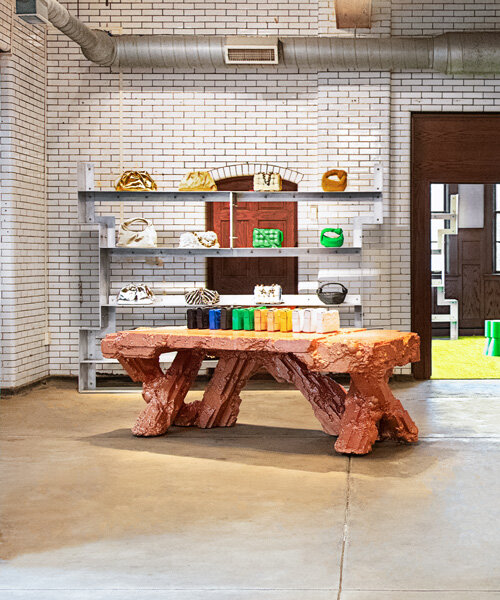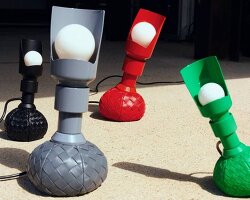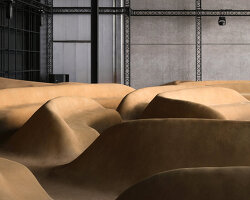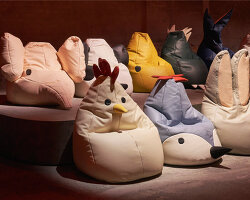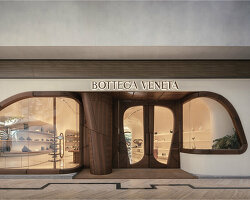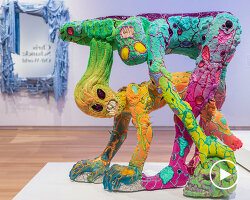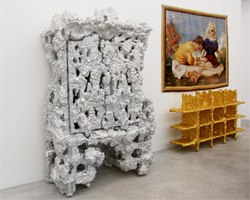BOTTEGA VENETA OPENS ‘BOTTEGA FIREHOUSE’ IN DETROIT
along with the presentation of its salon 03 detroit, which took place on october 22, 2021, bottega veneta has opened a new temporary space in the michigan city. as with its salon shows, the luxury fashion house aimed to engage with the local community of creatives in the making of this new hub, and thus brought on board furniture designer chris schanck, who opened his design studio in detroit in 2017. located on 1201 bagley street, ‘bottega firehouse’ showcases a series of schanck’s unique sculptural pieces, which are placed throughout the space together with works by aratani fay and kyle joseph, as well as bottega veneta’s latest clothing and accessories. meanwhile, nilufar gallery’s aluminum bookcase ‘XXXX’ by wendy andreu and bram vanderbeke serves as a display for the brand’s latest bag designs.
‘when something like the bottega veneta firehouse opens I savor it, because it’s exquisite for the sake of design and it should be in new york or london or paris but it’s not, it’s here,’ schanck tells designboom. ‘any detroiter can walk into the storefront and experience something world class; it’s the type of thing that would have completely blown me away as a young dallas art kid and it still inspires me today.’ read our interview in full and see images of the bottega firehouse, below.
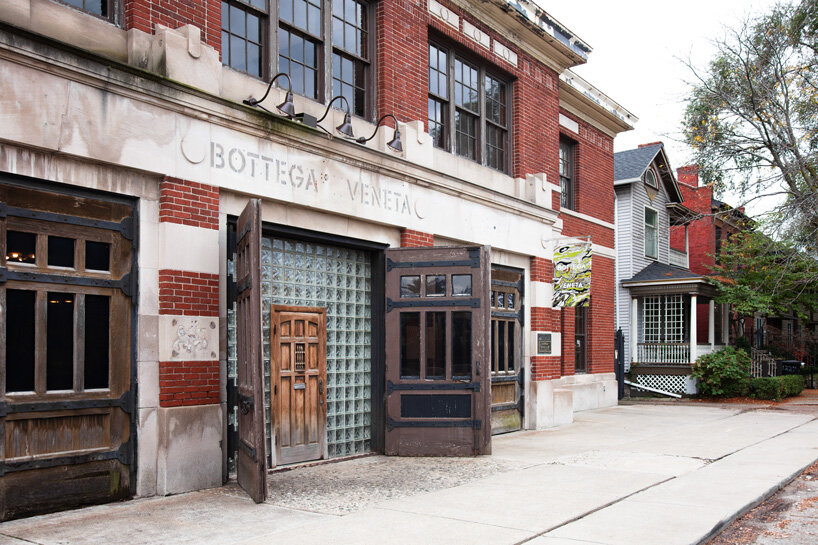 bottega firehouse detroit
bottega firehouse detroit
all images courtesy of bottega veneta
INTERVIEW WITH CHRIS SCHANCK
designboom (DB): how does the bottega veneta firehouse space tell a story of detroit?
chris schanck (CS): when I was a kid growing up in dallas, the only world class examples of design that I saw were in institutional contexts. I think about that a lot in detroit, the art scene I look up to here is determined and inventive, and prioritizes itself around community, not luxury goods and services. to say the least, of a city that has suffered exponentially without adequate infrastructure for decades.
so when something like the bottega veneta firehouse opens I savor it, because it’s exquisite design for the sake of design and it should be in new york or london or paris but it’s not, it’s here. any detroiter can walk into the storefront and experience something worldclass; it’s the type of thing that would have completely blown me away as a young dallas art kid and it still inspires me today. daniel lee has been able to create a remarkably transformative art and design experience in detroit.
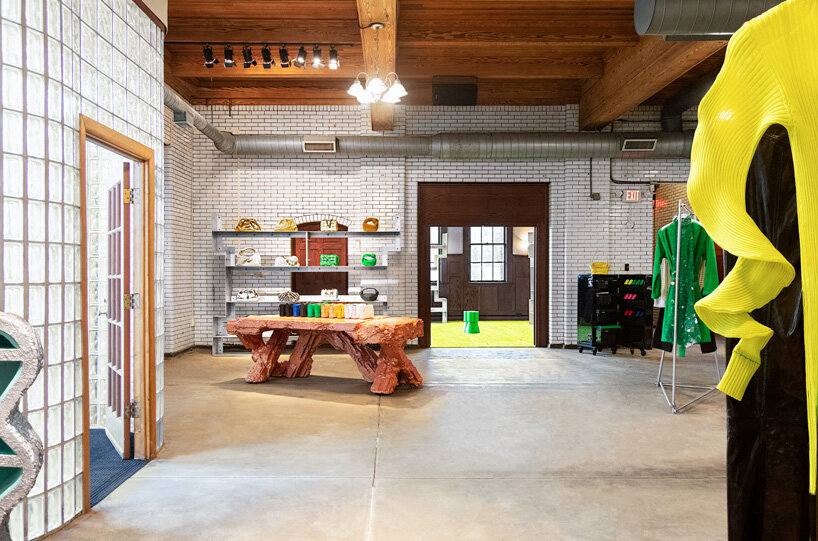
chris schanck’s pieces inside the bottega firehouse detroit
DB: in your opinion, is there a renaissance of detroit’s technical and creative innovation?
CS: the creative innovation within the arts and design space here in detroit never stopped; it´s persisted, often out of necessity, on the fringes of a city which has lacked a proper functioning infrastructure for a long time. there certainly has been a lot of momentum in the city in recent years, but I often think about all of the unwritten stories of creativity that have existed here–or even about the ingenuity in my neighbors’ gardening–and it becomes hard to orient myself around one story line.
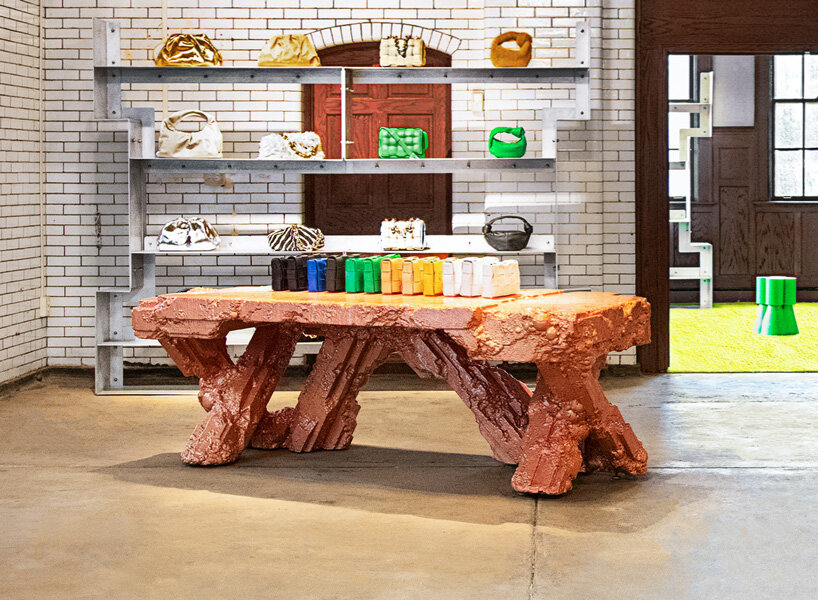
bottega veneta bags placed on bookcase ‘XXXX’ by designers wendy andreu and bram vanderbeke, nilufar gallery
DB: looking at your latest ongoing alufoil series, we’re wondering about the techniques that you use, please describe the steps and the difficulties you encounter.
CS: recent works have relied on the found object, we collect fallen woods, vines, bits of metal, home siding, and an abundance of unidentifiable ruble. these objects have varying characteristics, from organic to manufactured – I don’t have one specific method for grouping them. for each piece of work, my studio and I first build a simple structure and use that as an armature to explore the relationships between the objects and the material. the process of transforming the objects into form is driven by intuition and practical constraints. sometimes I’m following a hunch that two distinct things belong together, while other times I’m exploring rigid dimensional constraints between manufactured generic objects whose original intent is a mystery. it feels like a collaborative effort between myself and the material, I have a notion of where to begin but the objects bring the project into focus.
DB: are these self-created techniques? was there a learning process?
CS: yes they are, and the early works were quite clumsy. I’ve been told that I have a murderer’s thumbs – that would explain my heavy handedness at times. I can share with you what I’ve found to be useful advice from a few trusted colleagues -that is to be comfortable with not always knowing where you’re headed and to honor your own instincts and follow them as an act of faith. that’s helped give me a framework to understand early and insecure stages of a new process or idea.
DB: what is behind your philosophy of ‘unique objects of uncommon luxury’?
CS: I don’t recall ever saying that myself, but you know how these things take a life of their own. my intent was never to create luxury. most of the materials and techniques I use are inexpensive and provincial. it’s the craft and care that goes into the materials and methods that gives the work value. I was never exposed to objects of luxury in my own home. I found inspiration in museums and books. I’m agnostic at best, but I’ll kneel at the foot of an el greco. that’s not about admiring luxury, it’s a euphoric experience that transcends any idea of affluence or market value. my working philosophy is to make works from what I am instinctively, spiritually, or culturally drawn to explore. that work is meant to be shared and used. there’s a probability that my life and experiences will connect adjacently to someone else’s, and in the best case scenario that experience can act as a catalyst to share our stories with one another.
DB: you mentioned that your neighborhood of detroit influences your work?
CS: I’ve never in my life lived in one place for so long. growing up our family was always in a state of housing insecurity. for the first time, I’ve found stability, familiarity, and community – a great privilege. it takes time to know a place and its people. I’m slow to connect and adapt my surroundings into the work. it took years of observation and dialogue to begin to weave the vernacular of my surroundings into the work. I don’t always get it right, and I’ll always be an outsider to some degree. but I live in a community of outsiders, an aspect we share. with time, trust and friendships, a sense of belonging has developed into what I now consider home.
DB: which is more important, the planning design or the craft aspect in your work? can you calculate the exact final forms? the finish? or is there a moment of surprise each time?
CS: there’s no clear hierarchy of one over the other. drawing is the most personal and oldest part of my practice since I was a child. drawing helps enter an idea, but it’s only the beginning. everything changes when the material’s in your hands. I haven’t tried to calculate the exact final forms, I think my process is the antithesis to exactness. there is always a moment of surprise and inspiration but that is balanced with equal measure of disappointment and aggravation. seeking a balance and acceptance between compentasy and failure is a lifelong goal.
BTW
bottega veneta also opened another exciting temporary space, this time in london. located in the british capital’s buzzing shoreditch area, ‘bottega veneta redchurch’ features works by greem jeong, whose foam tube sculptures were included in the brand’s digital journal ‘issue 02’ (read our interview with the designer here). the space will be open until the end of december.
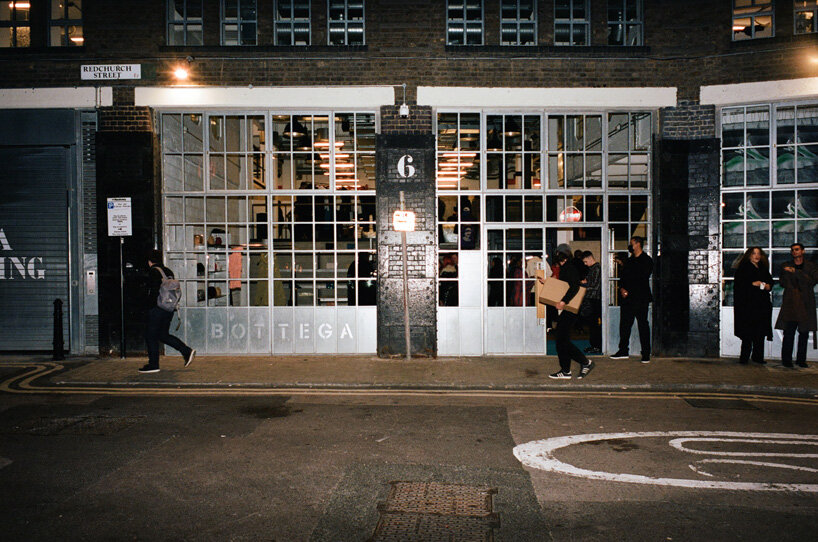
bottega veneta redchurch in london
project info:
name: chris schanck
brand: bottega veneta
bottega veneta (34)
chris schanck (3)
PRODUCT LIBRARY
a diverse digital database that acts as a valuable guide in gaining insight and information about a product directly from the manufacturer, and serves as a rich reference point in developing a project or scheme.
